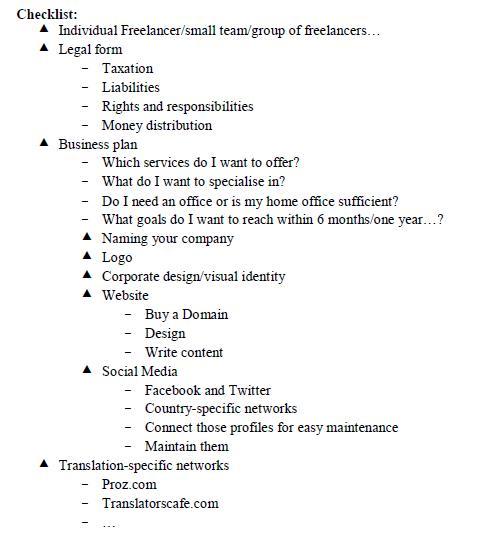
In Part I of this series, I talked about the general business issues you need to think before setting up a translation business. This second part therefore deals with websites, social media profiles and other networks, followed by a case study of my own business that is currently still in the planning stage.
Website, Social Media and Networks
You now have a name, logo and a corporate identity, the next step is to get a website. Firstly, you need to choose a domain name that corresponds to your business name and at the same is not too complicated to remember. Do not include a lot of dashes or dots in it or it will be impossible to remember for customers and they are unlikely to visit your site. Keep it short and simple.
Then, you need to choose an appropriate extension for your domain. The extension .com is most widely used, but you can also choose an extension that represents the country you are living in, like .de or .co.uk. With the domain usually comes a corresponding email address that you should use in any case – it is simply more professional to write emails from a @yourdomain.com address than from @googlemail.com or similar sites.
Now that you have everything ready you should have your website designed in accordance with your corporate identity and look. Again, I can recommend behance to find freelancers to help you or websitesfortranslators to work on the website design and implement it on your domain. Be sure to also adjust your email signature and other documents you use to include your web address to attract customers to your site.
You should also think about what you want to include on your site. Write content about you, your services and other issues you find important. Include your contact details and also keep legal issues that need to be included in mind. Decide on whether you also want to start a blog to write about your work experience and adventures. A blog is a good way to share thoughts with other translators and gain additional knowledge through comments. The visual appearance and content will form your website and represent you on the Internet as a business so make sure that everything is to your complete satisfaction before you publish it online. Nothing is worse than a site with a lot of typos and mistakes and visual flaws that customers can see.
Your web presence will be complemented by appearing on social networks. Get a profile on Facebook, Twitter, possibly LinkedIn, and Google+ to share your thoughts, talk about business issues and get in touch with customers, fans or other freelancers. There may also be country-specific networks, apart from Facebook or Twitter, that are worth registering at to attract customers. Check which networks are most commonly used by your target group and get an account there. If those profiles and accounts are customisable, be sure to include your corporate look on every page so that customers know it is you.
You should also connect all these profiles, if possible, so that you do not have to update each one individually. Most of them can be connected so that you have to update just one and the others will do it automatically. Include contact details and links to your website, blog and other social profiles. The most important thing here is that you actually maintain them – fans that follow you on those sites want to read some content and will un-follow you sooner or later if you do not post something regularly – be sure to invest an appropriate amount of time to maintain all these sites and get a benefit from them.
Lastly, apart from your website and social media, it is advisable to create profiles on translation-related sites and networks. There are hundreds of translation marketplaces that are worth having a look at and again, the ones you might want to use may differ from country to country. The most commonly used are Proz.com and Translatorscafe.com but there are a lot of other sites available as well. Language123, and TranslatorsTown are but a few.
There are also sites that are not specifically for translators but will help freelancers and companies to find work, such as MyHammer in Germany or PeoplePerHour in Britain. A Google search will tell you which sites are most widely used in your country to find professionals in a certain field. Get your profiles on those pages and include all your contact details, CV, pricing info and offered services. Think about whether you want to spend money on premium memberships for certain benefits on those sites.
Case Study
It is important to remember that all this takes some time and cannot be done within a week or even a month. You will need to spend a good amount of time thinking about these issues as they are really important. I was part of a team of translators called lingoprime, which we broke up for several reasons. After getting my own website, I talked to a fellow student, with whom I already worked as a freelancer during my lingoprime time and we decided to start a business together. We talked about this more or less loosely for quite some time before we actually really set to work on clarifying the idea.
We did quite some research on available legal forms for companies or teams of freelancers in Germany before we settled on a fitting one for our undertaking. This whole process easily consumed 1 or 2 months without any actual work being done except from the legal form (this may well be easier in other countries or with more knowledge in the field). We then set about searching for a suitable graphic designer for our visual identity and logo, which we found on behance. I actually wrote to 7 or 8 different companies and freelancers for quotes, negotiated with them and then we decided to work with br/bauen, who really did an amazing job (have a look at their portfolio!). This took about a month.
We have now filled out the design brief they require to start working on our project, so they will be able to start working by the end of the month and hopefully be finished within the next month. That means at least three months for the design process to get a visual identity and website design. The designers could have started earlier but they had to wait for us to choose a name for our business, which we found was the trickiest bit. We had a list of 20 possible names, some of which were already taken partly or completely. So we narrowed it down to 10, then came up with a couple more and narrowed it down again, came up with some more and so on.
Altogether I’d say it took us almost two months to decide to go with “Word&Sense” (obviously this can be done a lot quicker, but we put a lot of thought into it and are perfectly happy with this name). There are still some big decisions in front of us, which may consume a lot of time: We have to decide on a website design, maybe talk about our visual design, have meetings with a tax advisor, need to write and re-write website content and so on. But it is time worth spending for a result that is exactly what we want.
Summing up, we easily spent about seven or eight months for this whole process of developing an idea, clarifying it, getting designers and coming up with a name etc. We spend most of our time working on projects as well so we did not spend the whole day developing business ideas, but this is just to give an idea of how long it can take to get from A to B.
Take your time and do not rush it and you will get a result that is satisfactory and a good basis for your business. Below is a checklist based on all the issues I covered in this series, which I hope will help you start your own translation business as well.
Author bio:

I am 24 and studied translation at the University of Applied Sciences in Zittau and at the University of Salford, and have worked at a translation agency for half a year. Three years ago I founded and was part of a team of translators under the name of “lingoprime”. After this team broke up, together with a fellow student, we decided to establish a translation business called “Word & Sense”. I am currently writing my final dissertation and working part-time as a freelance translator, while getting our business ready to able to start working once I finish my studies this autumn.
Email: R.Seidel@reneseidel.de
Twitter: https://twitter.com/#!/word_and_sense









René, your two articles are great!!
I am currently thinking about starting my own translation company and I had most of these ideas scattered in my head, but your articles helped me structure them all in order to set up a real plan to start work efficiently.
Thank you and Keep it up
Nathalie
Thank you René for your article…. I am starting my translation company here in Canada.
Structuring my business is exciting but sometimes confusing…. You made it clear and simple.
I was wondering about getting customers from other countries and payment issues (means of payment, bad payers, etc.). Did you write an article about that? If yes, can you send me the link?
BTW: If you need an English to French translator for financial documents , do not hesitate.
Best,
Anne
anne.rulkin@hotmail.com
Hello René,
Brilliant articles..! Thanks for your kindness on publishing those useful guidelines. I am seriously considering to start a ‘translation business’ here in Australia and although I already had an initial strategy to start with, you made the road a bit easier to transit on.
All the best with your own business.!
Regards,
Carlos